An official website of the United States government
 United States Department of Labor
United States Department of Labor
August 2011
In terms of unemployment, the impact of the recent recession (December 2007–June 2009)1 was worse for the Riverside-San Bernardino-Ontario, CA metropolitan area (henceforth, Riverside) than for many others. Riverside’s unemployment rate, which has been consistently above the U.S. average over the last two decades, is currently the highest of all large metropolitan statistical areas (MSAs) in the United States at 14.2 percent.2 An examination of employment and wages in Riverside can provide insight into the current labor market situation there. This highlight shows that the occupation groups with lower wages and higher national unemployment rates were more concentrated in Riverside than in other areas.
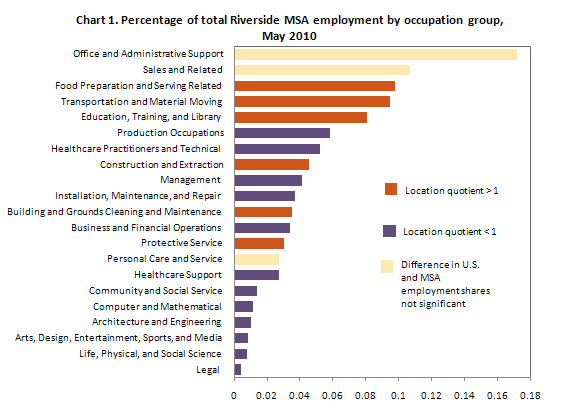
Chart 1 illustrates the distribution of occupational employment, showing the percentage of the area’s employment found in each of the 21 occupation groups. The chart also highlights the occupation groups that were more (orange bars), less (purple bars), or equally (beige bars) concentrated in Riverside than in the United States as a whole according to location quotients. A location quotient is the ratio of an area’s employment in an occupation to national employment in that occupation; a value greater than 1 indicates the occupation is relatively more prominent in the Riverside MSA than in the United States as a whole. The two largest occupation groups in Riverside—office and administrative support occupations and sales and related occupations—together accounted for slightly more than a quarter of employment. These two occupations, however, represented about the same proportion of employment in Riverside as in the nation.
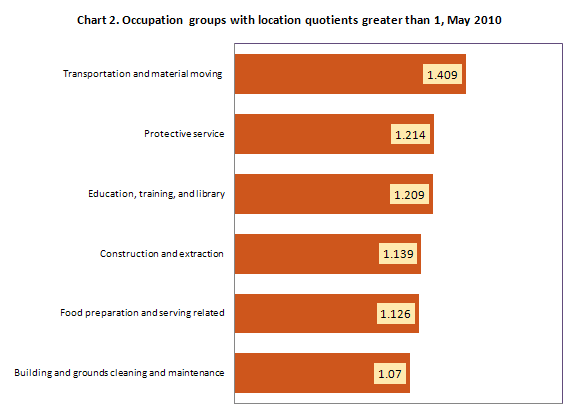
Chart 2 presents occupation groups with an above-average representation in the Riverside area as measured by the location quotient.3 Transportation and material moving occupations accounted for nearly 10 percent of employment in Riverside but only 7 percent in the nation, making it the occupation group with the largest location quotient. Nearly half of the employment in this group came from two detailed occupations: heavy tractor-trailer truck drivers; and laborers and freight, stock, and material movers, hand. Protective service occupations accounted for only a small portion of employment in Riverside (about 3 percent) but still more than its share of U.S. employment (2.5 percent). Nearly two-thirds of employment in protective service occupations was made up of three detailed occupations: security guards, police and sheriff’s patrol officers, and firefighters. Education, training, and library occupations, the fifth largest group overall, accounted for around 8 percent of Riverside employment and only 6.7 percent of U.S. employment. About half of the employment in this major group came from grade school teachers. The occupation groups with a location quotient of less than 1, presented in Chart 3, each accounted for 6 percent or less of total employment in the Riverside MSA.
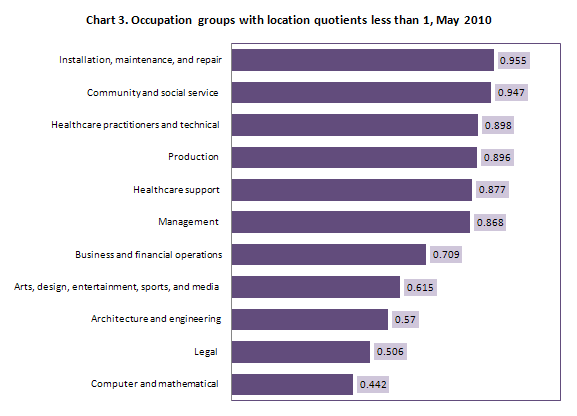
Unemployment rates by occupation are not available at the MSA level, but they are available at the national level for the major occupation groups. Charts 4 and 5 show the national unemployment rates for occupation groups with a location quotient of greater than 1 and less than 1, respectively. Notably, 5 of the 7 occupation groups with above-average representation in Riverside had a national unemployment rate that was above the 2010 U.S. rate of 9.6 percent, including one group—construction and extraction occupations—with a rate that was more than twice the U.S. average.4 In contrast, with the exception of a single occupation group—production occupations—the occupation groups with location quotients of less than 1 had unemployment rates that were below the national average, as illustrated in chart 5.
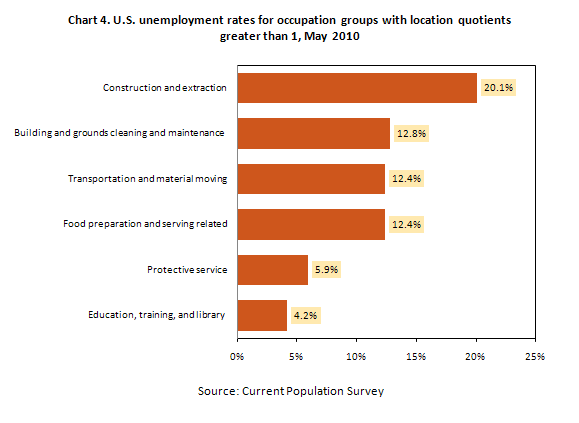
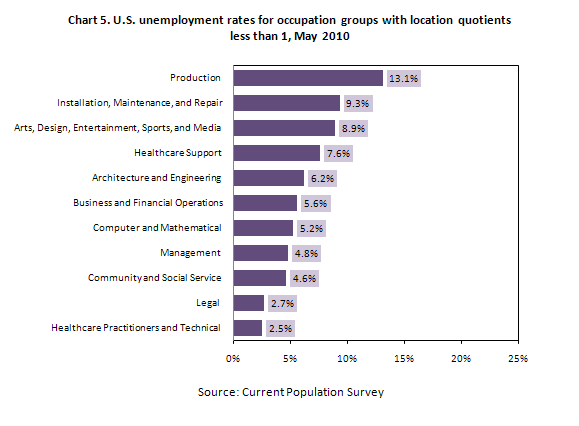
In 8 of the 21 occupation groups the average wages were higher in Riverside than in the United States as a whole. The average wage for all occupations combined in the Riverside MSA, however, was $20.64 per hour in May 2010, which was slightly below the U.S. average of $21.35. The overall wage was partially driven by the composition of employment: in general, the lower paying occupations had higher location quotients.
Chart 6 shows average hourly earnings for Riverside and the United States for the occupation groups with location quotients greater than 1. Five of the occupation groups with above-average employment representation in Riverside are among the lower paying groups. Four of the groups, however, had average wages that exceeded the U.S. wage for those occupation groups: protective service; education, training, and library; construction and extraction; and building and grounds cleaning and maintenance; in all but the latter, average wages were greater than the overall average for Riverside ($20.64 per hour). In two of the occupation groups shown in chart 6, the differences in average hourly wages for Riverside and for the United States were not statistically significant: transportation and material moving occupations and food preparation and serving related occupations.
Chart 7 compares wages for the Riverside MSA with those of the United States as a whole for the occupation groups with location quotients of less than 1. In general, wages for the groups with location quotients of less than 1 were much higher paying than those with location quotients of more than 1. For example, 9 of the 11 occupation groups in the former category had mean wages that were higher than the mean wage for all occupations. A comparison of mean wages for Riverside and the United States presents no definite patterns: four of the occupations had mean wages that were higher than the U.S. average, and five had mean wages that were lower.
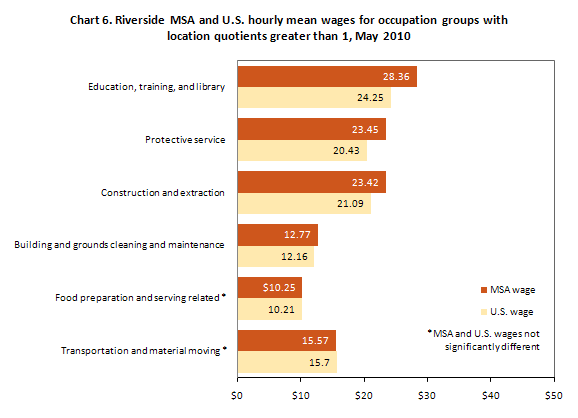
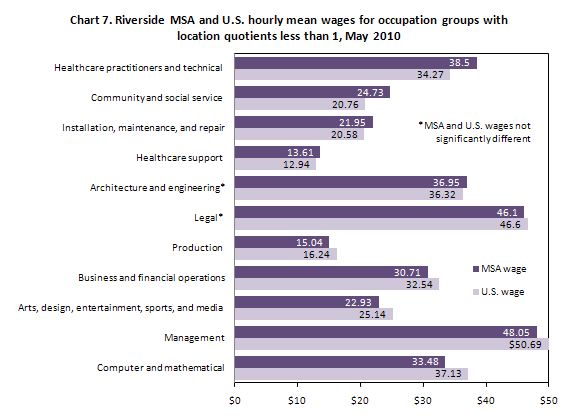
Chart 8 offers a summary of the occupation group employment and wages data by location quotient range.5 The percentages in the chart indicate the percentage of total MSA employment found in an occupation group within the corresponding location quotient range—greater than, less than, or not significantly different from 1. The wages in the chart indicate the average of the mean wages of the occupation groups found within the corresponding location quotient range. Perhaps the most notable feature in these data is that the average mean wage of $18.67 for major occupations with a location quotient greater than 1 is substantially lower than the average mean wage of $30.19 for occupations in the less-than-1 category.6
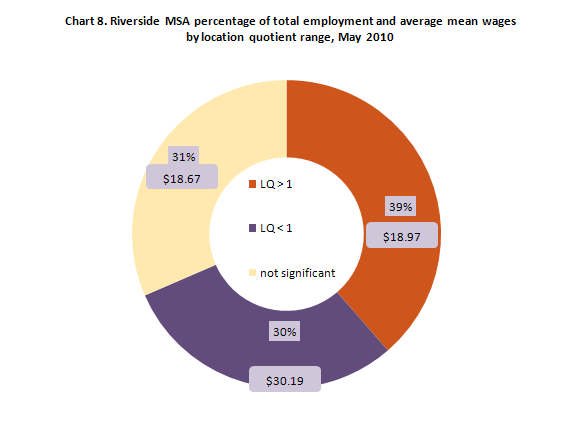
In addition to employment and wage estimates for occupation groups, OES data also feature estimates for detailed occupations. Chart 9 highlights the employment and wages of the 10 largest detailed occupations in terms of employment in Riverside. These occupations are mostly low paying. With the exception of registered nurses, all of the occupations had an hourly mean wage that was less than the average for all occupations. Hourly mean wages are not available for the sixth largest occupation in the area—elementary school teachers, except special education—but its annual mean wage ($65,950) was much higher than the annual mean wage for all occupations ($44,410).
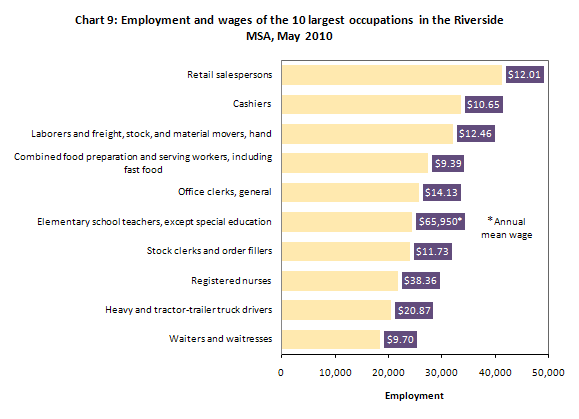
Chart 10 highlights the detailed occupations with the 10 largest location quotients. These occupations together make up a very small percentage of employment in the Riverside MSA (less than 1 percent). The occupations with the first and second largest values are found in the personal care and service occupations group and are both gambling-related: gaming service workers, all other; and slot supervisors. Three of the 10 are found in the construction and extraction occupations group: helpers—painters, paperhangers, plasterers, and stucco masons; tapers; and tile and marble setters. Two of the 10 are found in the transportation and material moving occupations group: aircraft cargo handling supervisors; and tank car, truck, and ship loaders. One occupation is found in the production occupations group: woodworkers, all other; and one occupation is found in the protective service occupations group: fire inspectors and investigators. With the exception of woodworkers, all other, all of the occupations are part of an occupation group with a location quotient greater than 1.
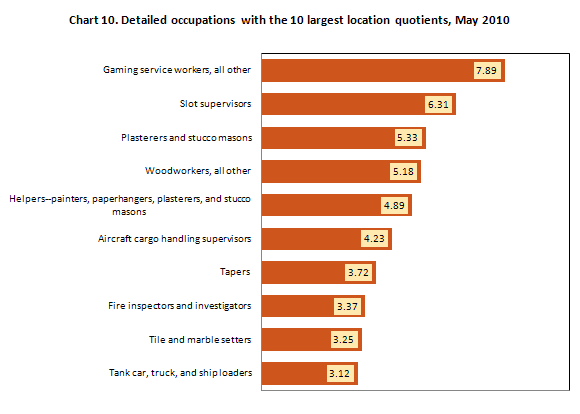
Chart 11 shows U.S. and Riverside wages for the detailed occupations with the largest location quotients. Although 6 of the 10 occupations had a wage greater than the corresponding U.S. wage for the occupation, no clear pattern emerges regarding the occupation groups to which they pertain. Each of the occupation groups with more than one detailed occupation represented in the chart had a detailed occupation with a wage that was above the U.S. wage for the occupation and one that was below. Only 4 of the 10 occupations had a mean wage that exceeded the mean wage for all occupations.
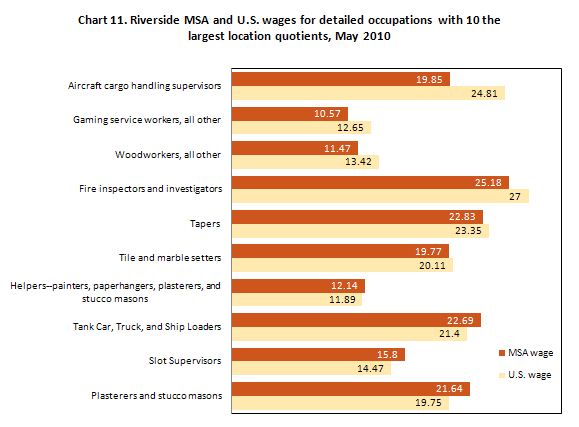
Complete Occupational Employment Statistics data for May 2010 are available from the OES webpage. This highlight was prepared by Tanner Beam. For more information, please contact the OES program.
Last Modified Date: February 7, 2017